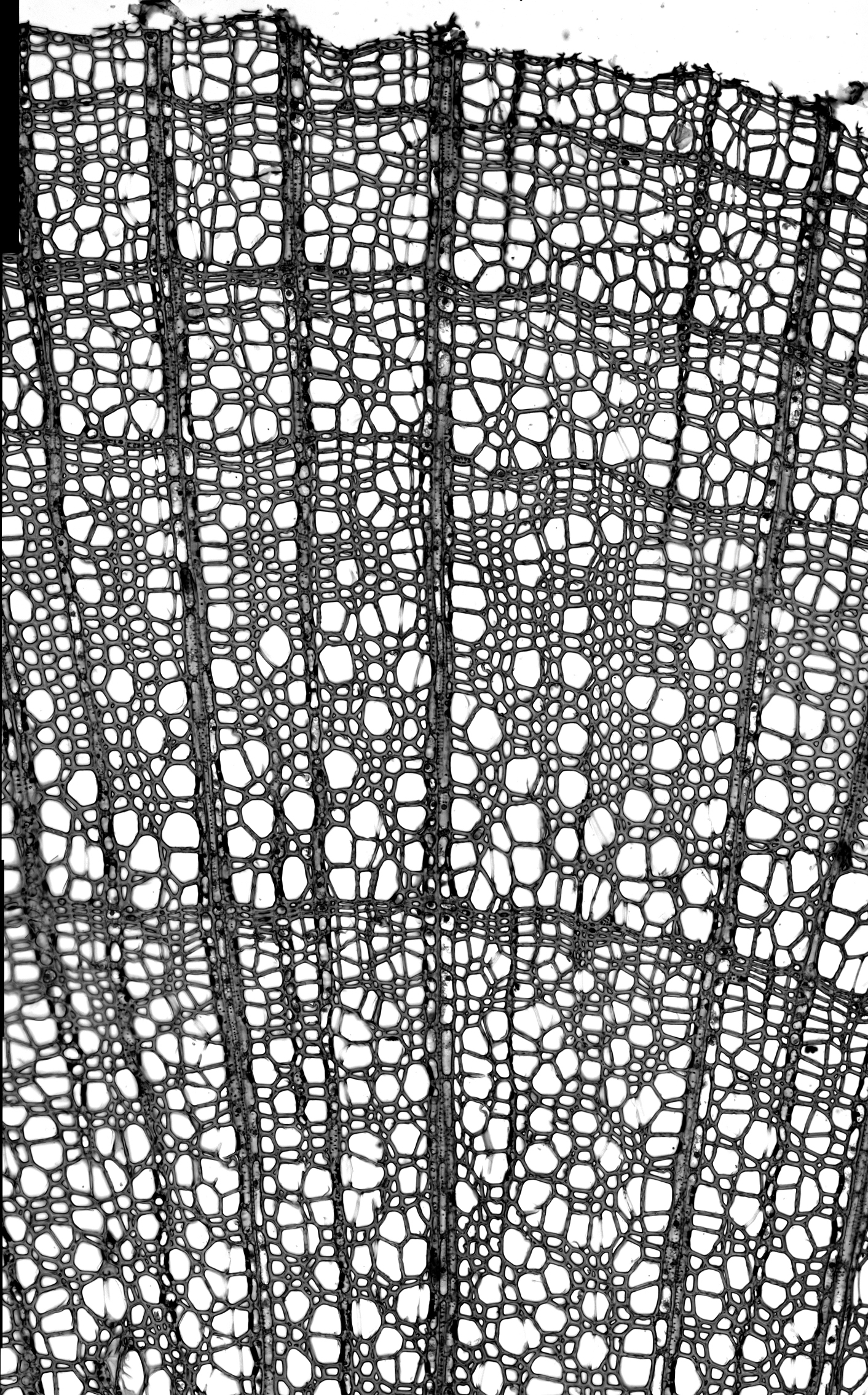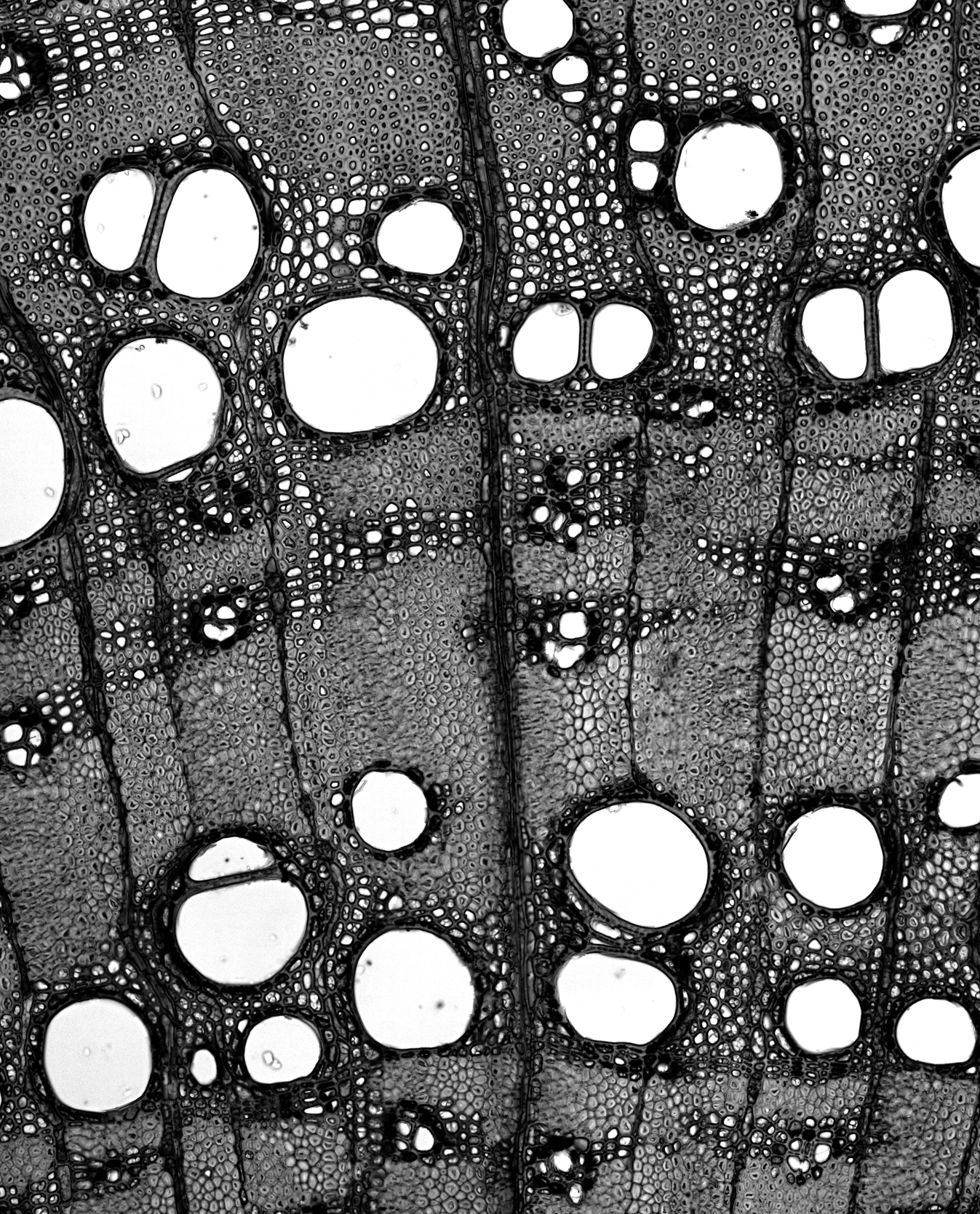Wood—also called xylem—provides mechanical support for plants, transports and stores nutrients, and transports water from roots to leaves. The proportion, structure, and spatial connectivity of wood tissues varies tremendously across species worldwide, but the functional meaning of much of that diversity remains unclear, leaving much for researchers to discover.
FIBERS look like small donuts within a cross-section. But in fact, they are elongated spindle-like cells. Across species worldwide, fibers are the most abundant wood tissue on average, but their proportion ranges from around 10 to 95 percent. In this American beech, fibers occupied 32 percent of twig wood volume and had medium-thick cell walls. Fibers primarily provide mechanical stability for plants—the strength to support limbs and resistance to environmental stresses like wind or snow.
PARENCHYMA is a three-dimensional network of living cells, with ray parenchyma connecting bark with inner portions of the stem and axial parenchyma running parallel with the length of the stem. This network stores and transports nutrients, which provide energy for building and maintaining living tissues. Parenchyma also contributes to pathogen defense, and it may factor into water storage and the continuity of water transport, although the exact mechanisms of these functions are yet uncertain. Parenchyma occupies between 5 and 90 percent of wood volume for species globally. In this American beech, parenchyma occupied 30 percent.
VESSELS are like pipes that transport water from roots to leaves. Their diameter is larger than other wood cells, and they differ tremendously across species, ranging from around 15 to 250 µm. The diameter has a huge influence on how efficiently water can be transported through wood. The larger the vessel, the more efficient the transport. In this American beech, average vessel diameter was 20 µm.
The Anatomy of Tree Life
There are myriad ways plants can make a living. Herbaceous annuals grow fast and live short, while other plants, like trees, grow slow and live long. Plants can produce cheaply built leaves that catch sunshine for only a few months, and others produce robust leaves that survive for several years. In a forest, shade-tolerant trees produce short stems, while sun-thirsty ones stretch tall. This marvelous diversity of form and function persists at the microscopic level, hidden to the naked eye yet biologically consequential.
Wood anatomy is not a new discipline. It has been studied since the seventeenth century, when Robert Hooke famously turned a microscope to a sample from the cork oak (Quercus suber) and coined the term cell based on the walled structures he observed. Shortly thereafter, in 1673, Antonie van Leeuwenhoek began observing the microscopic structure of cross-sectioned twigs from numerous woody species, including temperate and tropical plants. Over the next several decades, he rendered remarkably detailed illustrations, which are among the earliest progenitors to the images shown on the following pages.
Yet the intensity and emphasis of these anatomical studies has changed with time. An increased interest in wood anatomy in the nineteenth century was related to taxonomy—classifying differences between groups of plants—and Harvard University and other institutions built large collections of wood samples (usually rectangular blocks), which allowed researchers to easily compare wood from various species. This descriptive research continued into the twentieth century, although most of the studies were of qualitative nature, where anatomical structures were described using categories like “thin” and “thick,” instead of unit measurements. Over the past sixty years (and especially over the last two decades), however, an increased number of researchers started quantifying anatomical features, and importantly, they began considering the relationship between structure and function of wood on an ecological and climactic scale—attempting to understand why species adapted to disparate habitats possess different wood anatomies.



The three main wood tissues—fibers, parenchyma, and vessels—are also present in herbaceous plants, simply in different organizations. These tissues play several vital functions. They transport water and nutrients, while also providing nutrient storage, pathogen defense, and mechanical support. We are still learning about additional roles; for example, scientists have found that nutrients stored in wood might be used for maintenance of continuous water transport, not only for building new organs like bark and leaves.
Of the three main tissues, researchers have the greatest understanding of vessels, the cells responsible for transporting water. The average size of vessels varies hugely worldwide, from around 15 to 250 µm in diameter. We know that large vessels tend to be more susceptible to embolism—air blockage in a vessel—which impedes water transport and, if common, can be lethal. Embolism can be caused by freeze-thaw events or drought, so species exposed to such stresses tend to have smaller vessels. On the other hand, smaller vessels are less efficient for water transport. Beyond vessel diameter, plants can make many other anatomical adjustments to alter their hydraulic functioning. Some plants have lots of vessels, others very few, and plants can change the size of these structures across the growing season. (On the previous pages, large vessels can often be observed at the beginning of each growing season, when plenty of water was abundant, and the dimensions progressively shrink throughout the season.) Plants can also change how vessels are interconnected via the shape and size of small openings called pits.




Because anatomical measurements are time consuming, studies that look at highly detailed anatomy are usually limited to, at most, a few dozen species. Recent use of meta-analysis, however, has combined data from many individual studies, shedding light on anatomical variation worldwide—primarily for vessel diameter, vessel proportion, and parenchyma proportion.
As a Putnam Fellow at the Arnold Arboretum, my research focused on parenchyma, the tissue that is understood to store and transport nutrients, along with providing pathogen defense and water storage. One of the large-scale analyses had recently revealed that, across more than fifteen hundred species worldwide, the proportion of parenchyma in wood varies remarkably, ranging from 5 to 90 percent of the total volume (Morris et al., 2016). Species with the highest parenchyma proportions are only found in the tropics, yet species with little parenchyma are found in all climates: temperate, subtropical, and tropical. The functional meaning of this geographical distribution remains unclear, however, which is astonishing considering the dramatic extent of the variation.
Given the traditional understanding that parenchyma stores water, I investigated the hypothesis that woody species with a higher proportion of parenchyma would have greater water-storage capacity, allowing them to withstand drought more readily—essentially like having more water bottles in the pantry. Across thirty tree species that I studied in the Arnold Arboretum, however, species with more parenchyma didn’t necessarily store additional water, nor were they better at accessing whatever water had been stored. So the mystery of parenchyma proportion in wood continues to be unresolved. Presumably species with little parenchyma have entirely different life strategies than species with lots of parenchyma. This information will be important for helping us predict how plants will respond to increased aridity in many areas under climate change.
Citation: Ziemińska, K. 2018. Wood Under the Microscope. Arnoldia, 76(2): 18–23.
An anatomical perspective within plant sciences is essential for unravelling ecological and physiological questions about how species evolved to grow where they do. William Louis Stern—a professor at the University of Maryland—noted the need for this interdisciplinary approach in the pages of Arnoldia back in 1973. “Lest I am accused of being a wood anatomy bigot,” he wrote, “let me hasten to say that I do not believe that studies in wood anatomy can remain viable in a vacuum; rather, they must be integrated with other studies in plant anatomy and with other phases of botanical endeavor.” Wood anatomy is time-consuming and slow—requiring patience and meticulous microscopy skills—but the more we know, the more we realize that we still have much to learn.
Work Cited
Morris, H., L. Plavcová, P. Cvecko, E. Fichtler, M.A. Gillingham, H.I. Martínez-Cabrera, D.J. McGlinn, E. Wheeler, J. Zheng, K. Ziemińska, and S. Jansen. 2016. A global analysis of parenchyma tissue fractions in secondary xylem of seed plants. New Phytologist, 209: 1553–1565.
Kasia Ziemińska is an Arnold Arboretum research associate and a recent postdoctoral Putnam Fellow.
